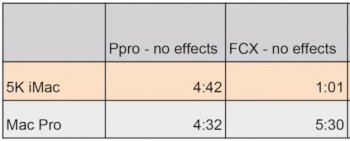It was edited and rendered in FCPX, then like most expensive Hollywood movies, it was color corrected using a high end system like Quantel's Pablo Rio:
https://s-a-m.com/products/quantel-rio-–-complete-color,-editing-and-finishing-tool/c-24/p-173
First let me correct the budget. It appears "Focus" cost $50 million to make. However they aren't going to jeopardize a $50 million production by editing on a system that can't do the job or does it too slowly. In this case the editors were not Mac fanatics -- they had plenty of experience on various platforms.
Much of the movie was edited in iMac 27s, not Mac Pros. They used 32 terabyte locally-attached Thunderbolt arrays. Toward the end of post production they got some Mac Pros but the editors said iMac performance was great. This is all discussed in the book by 1st Assistant Editor Mike Matzdorff:
http://amzn.com/B00UO2NA8I
The relevance is if we can edit major films on iMacs when the post production costs are thousands of dollars per day, what's the big problem with iMac 27 performance?
There are obviously specialized narrow-market cases that require higher end hardware, such as the above Quantel Pablo Rio system. Apple is not going to spend many millions of dollars developing for niche markets like that.
The problem is, you're taking the argument the wrong way; from the aspect of most who have never taken part in a complete production. Editing is literally the simplest (technically, not artistically) and least intensive task. The iMac is great for editing; and big budget companies are exactly those who have the money to blow on several iMac workstations, since they have money for better stuff as well, and a single person won't be handling it all themselves.
But as anyone who's ever worked for a small to mid-size production company, these aren't "specialized" needs. These houses usually don't have the money to invest in more than 4 workstations; and yes the iMac is fine for editing, and sometimes even rendering out - but by no means is it a fully capable machine. And it's not even like it requires Pablo Rio to blow it out of the water; tons of computers are far more capable than the iMac - for less than the price of the iMac.
A 12core old mac pro can easily kill the top of the line iMac and nMP, when you are handling entire productions on a single system. The ability to complete CG, color, editing, and rendering is a necessity for many smaller firms. This is where the iMac becomes a relative 'waste' for lower budgets. Now for wedding video editors, or event videography companies, and simply for editing, an iMac will serve its purpose fine and well. But companies that produce high end commercials and start-to-finish productions with several aspects; it's not going to cut it.
To compete, many smaller firms and contractors have to create 2.5k and 4k AE comps that bring the newest iMac to a complete crawl. The lack of graphics upgrades and Vram increase is the basis of this argument against the thinness of the iMac. As anyone will tell you, a 4gb graphics card (as on a fully upgraded imac; even though most have 2gb - a complete joke for anything graphics related other than playback.) on a high end machine is almost pointless; considering 6-12gb barely cuts it on making certain projects workable.
When it comes to decision making for many companies, here is the deal: spend $4,100 on a single iMac 'workstation' that requires them to also buy another computer for anything with intense graphics requirements; or spend $2,900-3,500 on a used Mac Pro 12 core with dual 980ti's, more ram, up to 4 SSD's, etc. that will be able to handle editing, color, and CG? And again, there lies the issue with the iMac and its thinness. It is good for about 1/6 of the work required for a complete production; excellent if you have 6 people doing each part; horrible if your company can't afford that.


